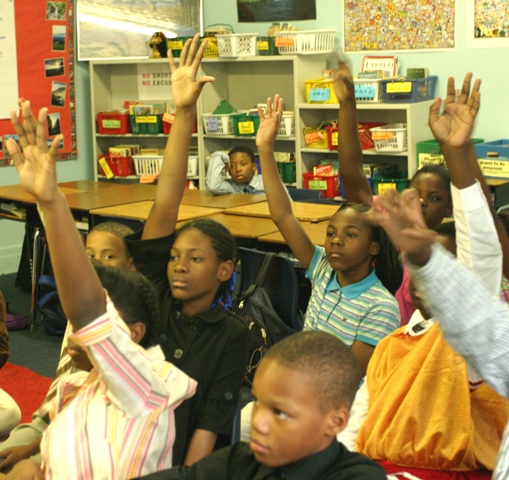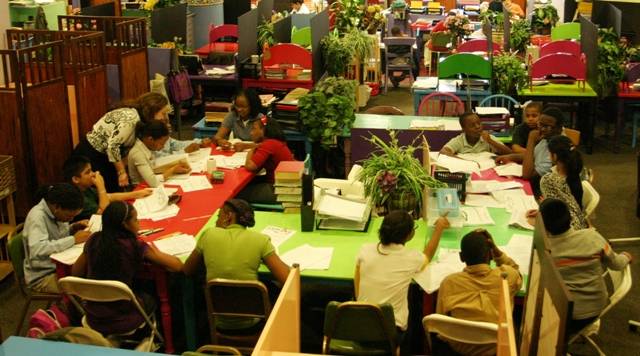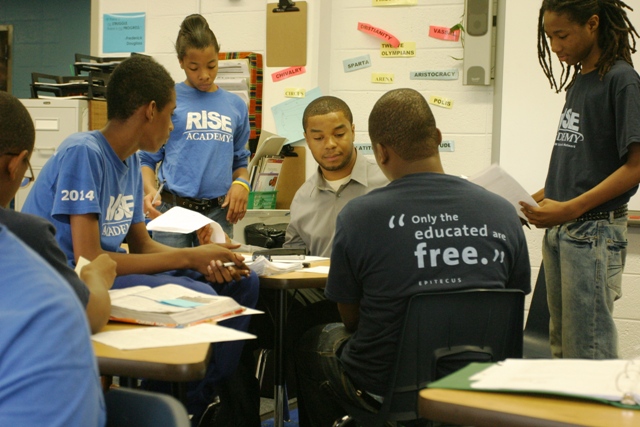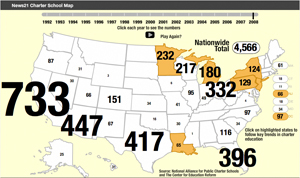A Tale of Two Charters
Sharon McCloskey | Jul 30, 2009 | Comments 7
By Sharon McCloskey, with reporting and production by Karn Dhingra, Paul Stephens and Michele Hoos

(PHOTO:SHARON McCLOSKEY/NEWS21)
For the past decade, two veteran educators have operated Discovery Charter School in Newark, N.J., on a shoestring, teaching out of a renovated single-floor open space that is, in every sense of the word, the quintessential one-room urban schoolhouse. With quiet innovation and little fanfare, Irene Hall and Barbara Weiland have lifted their students beyond proficient testing averages and placed graduates in elite boarding schools.
Across town, two newer charters are vying for similar academic results, but with national attention and entrepreneurial support. RISE Academy and TEAM Academy are part of the storied KIPP, or Knowledge Is Power Program, network of charter schools. Bigger, better funded, and often in the media’s eye, these two charter schools represent the latest trend in urban schooling, where rules and structure reign. With a smart business plan and a developing track record, KIPP is intent on replicating its model across the map.
Two charter schools in one city, competing for similar resources, space and students. One is rooted in the community of Newark; the other belongs to a national network. One is led by Newark educators, the other by out-of-town Teach for America alumni. One has plans to stay small, the other has aggressive plans to expand. One wants to change how children learn, the other aims to prepare them for life. One needs money, the other – not so much.
In Newark, Discovery Charter and the KIPP schools frame a debate percolating beneath the charter school explosion. If charter schools are leading the public-school reform movement, what should be their guide star? Should they grow from within, aiming to lift the community as well, or should they expand from without, preparing students for college and a life beyond? With charter schools moving into adulthood, some say that the time has come to consider what makes the most sense for the future of urban public education.
“For any charter school to work in Newark, it has to work in context,” said Mary G. Bennett, executive director of Project GRAD Newark, a nonprofit organization that tracks performance of Newark schools. Bennett has lived and taught most of her life in Newark, getting her start at Barringer High School more than 35 years ago. “Charter schools have to take the time to get to know the city, to know the folks of old Newark and to know the kids, what they’re bringing with them to school.”
Discovery and the KIPP schools operate within the limits of the same city, serve the same student population and receive the same public funding. Yet together they represent divergent paths in the evolution of the urban charter-school landscape. Discovery, born and bred in Newark, wants to continue growing through the community and help make Newark schools into beacons, bringing better-educated students into the life of the city. KIPP wants to expand its national brand in Newark in order to provide more kids with a steppingstone to a better life beyond city walls.
The Newark Landscape
Long one of the poorest cities in the nation, Newark has the largest school district in New Jersey — more than 40,000 students attend its 90 public schools, including 18 charter schools. The district has been under state control for more than a decade, due to poor student performance and a lack of fiscal accountability.
Despite, or perhaps because of, its reputation as a struggling, impoverished city, Newark has attracted the attention of a growing group of education entrepreneurs, including the Gates and Oprah Winfrey foundations. Philanthropy Magazine recently highlighted the city as a bright spot on the philanthropic horizon because of its size and its core of successful charter schools.
Newark’s first two charter schools opened their doors in 1997. Though both emanated from the experiences of veteran Newark educators, only one was free-standing; the other, part of a nascent charter organization. Growth through 2001 was steady but not rapid, in part because of New Jersey’s tough charter school laws. The next six charter schools were all homegrown.
All that changed when KIPP came to town in 2002. Over the following seven years, KIPP opened four schools in Newark, serving students from kindergarten to 12th grade and eclipsing the growth of free-standing charters. During that same time, only two independent charter schools opened their doors in the city. (An additional KIPP school is planned for 2010; one more independent school is slated to open this fall.)
When Newark’s KIPP schools fill their enrollment by 2015, they will have captured at least 5 percent of Newark’s public-school population. KIPP’s rapid growth in the city rivals its expansion in New Orleans and the District of Columbia, leaving some to wonder if space remains in the Newark charter-school landscape for schools of different origins and philosophies.
Urban Schoolhouses
Not all children look the same, and not all children learn the same. Of course, then, all schools should not be the same.
Though barely a mile apart, Discovery and KIPP’s middle schools look and feel worlds apart.
Discovery Charter School sits among the pawn shops, abandoned office buildings and shuttered stores all too common in Newark. Its bright awning, peering out from the side of a former United Way building (itself an abandoned renovation project), is easy to spot through the surrounding metal fence, de rigueur in this neighborhood.
At Discovery, all visitors are welcome. No appointment necessary, though you do have to be buzzed in through the fence.

Class at Discovery Charter School (PHOTO:SHARON McCLOSKEY/NEWS21)
Inside you’ll find 10,000 square feet of open space, alive with color and packed to the rafters with stuff. There are no classrooms here, just pockets for learning. Picture a richly-stocked nursery school — for all ages. There’s a picnic table with an umbrella in one spot, groups of looms in another, and a “red floor” area for science and Lego work. Each student has a separate work space — a wood desk painted pink, teal or purple, scattered around the room. A first-time visitor might think she’s stumbled into a friend’s family room, not an urban middle school.
From high atop a chair on center stage, Barbara Weiland oversees the day’s activities and dispatches students by microphone from one area to another as necessary. On any given day, those students could be working on their Lego machines, drafting legal arguments, or starting to design a boat. And reading, always reading, at least one book a week.
Lessons are never quite set, depending upon the events of the day and the direction class discussions are headed. Teachers have to adjust accordingly. “I’m never quite sure what to expect, day-to-day,” said Denis Cretinon, the school´s science teacher and Lego wizard. When you’re teaching children to learn, he said, there’s opportunity everywhere.
Across town at KIPP’s middle schools, you do need an appointment. And an escort.
TEAM Academy and RISE Academy occupy the staid structures that once housed two Catholic schools. Inside, the quiet order and by-the-clock structure are reminiscent of their parochial predecessors. Signs lining the walls remind students that appropriate behavior is very much part of the school’s culture. “No excuses — No shortcuts,” one reads. At times, students line the walls, too – to use the bathroom or to move from class to class.
In classrooms, teachers call their classes to order with clapping, and rapid-paced questions and answers follow. Students snap their fingers to agree with a classmate’s answers, and must, at times, check their “SLANT” — a slogan that reminds them to “Sit up, Listen, Ask questions, Nod heads” and “Track the speaker.”
Here, everything must be earned, including the blue KIPP shirt worn as part of the required dress code. There’s another shirt, too — a yellow one – worn by students who have chosen to ignore the rules. Chances are the students in yellow shirts will also be sitting in silent lunch, where no one speaks.
Lesson Plans
Twenty-five years in any school district is a long time. In Newark, it might be considered an eternity. Barbara Weiland has spent that, and more, teaching in Newark. Is she jaded? Not at all.
“The great thing about teaching here was that they left you alone. Newark schools gave us the freedom to create,” said Weiland. That freedom, she added, enabled her and Discovery’s co-founder and co-leader, Irene Hall, to develop and tweak their approach to teaching.
“People learn by building on what they know,” Hall said. “So before you can start teaching a child, you have to know what he knows and how he learns.” Hall tells the many alternative-route teachers who come through her school that they cannot expect to design a class over the summer and be successful. “You simply don´t know the kids yet. You haven´t made that connection.”
Weiland and Hall focus on developing their students as independent thinkers and learners, and seek, as teachers, to be facilitators only.
“We´ll do a little kill-and-drill, some memorizing, but mostly we´ll be learning by doing,” said Hall. When students have to work through a problem or process, she added, they own the result.
With Legos, for example. It may look like only child´s play, but so much more is going on. While students in other schools may be reading about how gears work, at Discovery, they´re making them work. Students might have to design a multi-functional piece – one that moves different ways and makes noise. They have to do some research and learn (often by trial and error) how the gears work. They must articulate and defend their designs in writing, And then they build them.
Indeed, “how things work” could be Discovery’s textbook. But, actually, the New York Times is. It´s all there, said Hall — history and politics, science, travel and the arts. The newspaper, and supplement packets teachers create, are all the tools needed to teach their students to think and learn.
And just how are things working at Discovery Charter School? From the state testing perspective, its scores have ranked consistently among Newark’s top schools.
Kipp Way or No Way
KIPP is rapidly becoming the stuff of legends. Jay Mathews, the Washington Post’s education reporter, memorialized KIPP’s rise in his book “Work Hard. Be Nice,” pointing to its success in raising students’ standardized test scores and moving children from some of the nation’s poorest homes into college.
And across town from the Discovery Charter School, the KIPP way is hard at work.

Class at RISE Academy (PHOTO:SHARON McCLOSKEY/NEWS21)
KIPP is tough love on steroids. Its mantra, that “all children will learn,” had its origins in a siege mentality, a belief that the only way low income children could learn was by securing the premises, shutting out external influences, raising expectations and demanding acceptable behavior. It is not a kill-and-drill boot camp, certainly — the smiles on student faces and the buzz about the trips and the opportunities KIPP provides– attest to that. But without question, it is the KIPP way or no way for its students.
Newark’s TEAM schools are no exception. Our limited glimpses inside TEAM and RISE Academies revealed KIPP on cruise control. The teaching was little different from that formulated by KIPP’s founders, Dave Levin and Mike Feinberg, years ago, though that lack of a dynamic pedagogy might indeed be endemic to charter schooling in general. “With a few exceptions, most of the innovations in charter schooling have been on the management and organizational side of schools, not in the classroom,” wrote Andrew Rotherham of Education Sector (an independent think-tank) in “Achieving Teacher and Principal Excellence: A Guidebook for Donors.”
KIPP fans dispute the “formulaic” characterization of their schools, arguing that each school is very much a reflection of its individual leaders. Is that true in Newark? Unfortunately, we could not find out. Despite our repeated requests, TEAM’s leaders - young imports from the Teach for America program - would not agree to interviews.
Are all children learning in TEAM’s schools? Based upon reported state test results, the answer is yes, though not at the proficiency levels of the more established Newark charter schools such as Discovery.
Spending Your Allowance
By law, New Jersey charter schools should receive 90 percent of the per pupil funding that other public schools in their districts get. In reality, they get much less. Discovery and TEAM receive only 60 to 70 percent of the public funding allocated to other Newark public schools.
Both schools appear to spend roughly the same amount per pupil, according to Department of Education comparative cost statistics. In 2008, Discovery spent $12,521 and TEAM (combined for all schools), $12,508, significantly less than the $19,305 per pupil that Newark Public Schools spends. TEAM has lower administrative costs –the benefit of being able to share costs across its schools–but pays its teachers more.
By its own admission, though, TEAM’s per pupil spending — which is roughly its (and Discovery’s) per pupil government revenue, is not enough to cover its costs. KIPP estimates that it needs an additional $1500 per student beyond its public funding to support programs and services it considers central to the KIPP mission, such as higher teacher pay, Saturday school costs and its annual field trips to Washington, Utah and area colleges.
TEAM funds these costs from private donations. For the year ending June 30, 2008, it received an additional $1 million in revenue from its supporting foundation, Friends of TEAM, which owns the TEAM school buildings. Friends of TEAM itself reported revenues from direct public contributions of almost $2.3 million for that year.
TEAM´s list of donors includes a host of local and national foundations, like the Bill and Melinda Gates Foundation, the Walton Family Foundation, the Charter School Growth Fund, and its own network foundation - the KIPP Foundation. The Charter School Growth Fund alone contributed $500,000 to TEAM’s foundation in 2007 and has awarded an additional $3 million in grant money to support TEAM’s expansion in Newark.
With this philanthropic support, TEAM ends its school year very much in the black. For 2008, TEAM schools reported net assets of $1,042,689.
Discovery´s revenue, on the other hand, begins and ends with the per-pupil money it receives from state and local sources. It has, over the years, received small amounts from grants and contributions – mostly from local organizations. For the year ending June 30, 2008, Discovery reported private grants of $42,625.
And despite its lack of outside funding, Discovery ends its school year in the black. For 2008, Discovery reported net assets of $11,494.
Though both schools start out with the same government allowance, the KIPP schools are able to draw from a much larger pool of resources. Only with those resources are they are able to fulfill the KIPP stated mission that “all children will learn.”
What Should We Learn?
Once upon a time, KIPP was just an idea – to some, the fantasy of two young and inexperienced educators. As it grew, it brought attention to charter schools across the country and redirected the conversation about school choice and quality education. Certainly, then, its expansion and success is a tribute to the power of new ideas.
Lots of attention and money has been directed towards the expansion of KIPP and the replication of other similar network schools. The KIPP brand has traction, to be sure, but not everywhere. Failed attempts at opening schools in places like Asheville, N.C., where KIPP could not seat enough students, demonstrate that.
During the same time, schools like Discovery Charter have subsisted, and flourished, with public money alone, validating their place on the charter school landscape.
Without question, KIPP has changed the conversation about public schools in this country. Ironically, though, as charter schools become mainstream, the dialogue may move away from replication of the KIPP model towards more thoughtful consideration about how charter schools can and should evolve.
Mashea Ashton, a partner in the Newark Charter School Fund, wonders if that’s a dialogue worth having, given the dire school statistics cities like Newark face. “The question shouldn’t be do we have more local schools, or more KIPP schools,” says Ashton. “We should have more quality schools – public, charter, KIPP, local, whatever. And we need to get them all enough money to succeed.”
But Erin Dillon, senior analyst for Education Sector, believes it’s a conversation that needs to be ongoing. For any school system to be dynamic, there has to be room for the innovators, says Dillon. And replication is not innovation.
In “Food for Thought: Building a High Quality School Choice Market,” Dillon contends that choice is essential to effective schooling and that quality choice emerges from each community’s needs. To that end, one size does definitely not fit all. And Dillon suggests that urban educators can take a page from the success of the oft-overlooked lords of urban economic underworlds — check cashers, fast-food purveyors, convenience store proprietors, and the like. Despite the illogic of patronizing such establishments, residents nonetheless do, because these places have arisen from and belong to the community, and their proprietors know their customers.
Says Dillon: “Districts should do more than just solicit community input during the initial process of recruiting and opening schools; they should also create and sustain avenues for community organizations and members to start their own schools and develop partnerships with school operators.”
Mary Bennett, one of the sage voices of Newark, thinks a balance can be struck. “Knowing the community doesn’t mean you have to repeat its mistakes,” she said. “That’s how you grow. But you do have to learn what those mistakes were.”
So how should our public school districts evolve? Will they be all charter? Can they be all KIPP, and should they? Who should be the players?
Differences in philosophy may abound, but all will agree that education reform must be ongoing. And by definition, innovation is not static.
“If there is a better way, we find it.” So said Mike Feinberg and David Levin, founders of KIPP.
Let the conversation begin.
Filed Under: Featured • Newark • Unchartered Territory
About the Author:














Summary of news of Tiger Woods
This is the first I’d heard of KIPP. It was great to read about all the good they’re doing in Newark, etc. I’d like to hear some more….
Just browsing around and found your site. Very good post. Will be adding you to my RSS reader.
I am so happy that Mr. Silver got a moment of shine. He has made a huge difference in the lives of so many students at Rise. He always finds a way to make light of a grim situation. WAY TO GO, MR. SILVER!
Congrats on such a great post. I really enjoyed reading it. Thanks!!
GO MR. SILVER!!!!!!!!!!!!!!!!!!!!!!!!!!!!
go rise academy… my fav teacher mr.silver ROCKS!